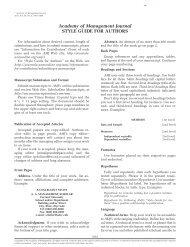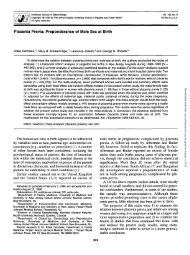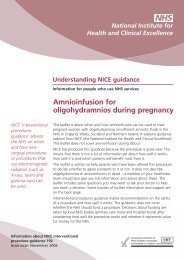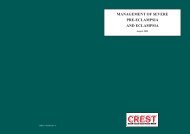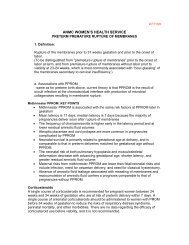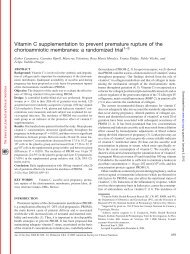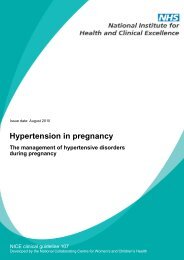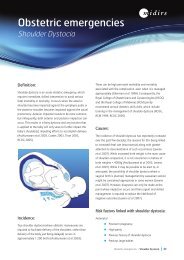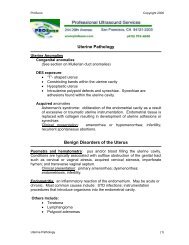Antibiotic Therapy in Preterm Premature Rupture of the Membranes
Antibiotic Therapy in Preterm Premature Rupture of the Membranes
Antibiotic Therapy in Preterm Premature Rupture of the Membranes
Create successful ePaper yourself
Turn your PDF publications into a flip-book with our unique Google optimized e-Paper software.
SOGC CLINICAL PRACTICE GUIDELINEdifferences <strong>in</strong> subgroup analyses (presented above). Dataon long-term outcomes among children from this trial werepublished <strong>in</strong> 2008. After seven years <strong>of</strong> follow-up, <strong>the</strong>re wasno difference <strong>in</strong> <strong>the</strong> proportion <strong>of</strong> children with any functionalimpairment <strong>in</strong> <strong>the</strong> group born to women whoreceived erythromyc<strong>in</strong>, with or without co-amoxiclav, and<strong>in</strong> <strong>the</strong> group born to women who received noerythromyc<strong>in</strong>. 13In addition to <strong>the</strong>se two trials, many o<strong>the</strong>r studies have beenpublished assess<strong>in</strong>g <strong>the</strong> efficacy <strong>of</strong> antibiotics follow<strong>in</strong>gPPROM for pregnancy prolongation and reduction <strong>of</strong>maternal and neonatal morbidity, with different regimensand duration <strong>of</strong> treatment. They <strong>in</strong>clude studies document<strong>in</strong>gan <strong>in</strong>crease <strong>in</strong> <strong>the</strong> latency period <strong>in</strong> women who receivedimipenem/cilastat<strong>in</strong> 14 and mezlocill<strong>in</strong>. 15 In a study compar<strong>in</strong>gduration <strong>of</strong> <strong>the</strong>rapy, all patients received 48 hours <strong>of</strong>parenteral ampicill<strong>in</strong> and were <strong>the</strong>n randomized to receiveei<strong>the</strong>r three or seven days <strong>of</strong> oral ampicill<strong>in</strong> follow<strong>in</strong>gPPROM. There was no difference between <strong>the</strong> two regimens<strong>in</strong> <strong>the</strong> ability to achieve a seven-day latency period,and no difference <strong>in</strong> <strong>the</strong> <strong>in</strong>cidence <strong>of</strong> maternal or neonatalmorbidity. 16Larger reviews have also been performed to assess <strong>the</strong>effects <strong>of</strong> antibiotic adm<strong>in</strong>istration <strong>in</strong> women with PPROMon maternal and per<strong>in</strong>atal morbidity and mortality, and toattempt to identify <strong>the</strong> antibiotic(s) <strong>of</strong> choice. Kenyon andcolleagues published a systematic review <strong>of</strong> 19 trials <strong>in</strong>volv<strong>in</strong>g6951 women, <strong>of</strong> which 14 were randomized controlledtrials. 9 Participants were enrolled from 21 to 37 weeks’ gestationalage, and several different antibiotic regimens wereused. <strong>Antibiotic</strong>s were associated with a statistically significantreduction <strong>in</strong> <strong>the</strong> number <strong>of</strong> <strong>in</strong>fants born with<strong>in</strong> 48hours (RR 0.71; 95% CI 0.58 to 0.87) and 7 days (RR 0.80;95% CI 0.71 to 0.90) <strong>of</strong> PPROM. In those exposed to antibiotics,<strong>the</strong>re was a decrease <strong>in</strong> chorioamnionitis (RR 0.57;95% CI 0.37 to 0.86) and several aspects <strong>of</strong> neonatal morbidity<strong>in</strong>clud<strong>in</strong>g neonatal <strong>in</strong>fection (RR 0.67; 95% CI 0.52 to0.85), positive blood culture (RR 0.75; 95% CI 0.60 to 0.93),oxygen <strong>the</strong>rapy (RR 0.88; 95% CI 0.81 to 0.96), treatmentwith surfactant (RR 0.83; 95% CI 0.72 to 0.96), and abnormalcerebral ultrasound (RR 0.82; 95% CI 0.68 to 0.99).Overall, <strong>the</strong> use <strong>of</strong> antibiotics was not associated with a significantreduction <strong>in</strong> neonatal mortality (RR 0.91; 95% CI0.75 to 1.11).In terms <strong>of</strong> specific antibiotics, benefits were seen (pregnancyprolongation and decreases <strong>in</strong> neonatal morbidity) <strong>in</strong>trials us<strong>in</strong>g penicill<strong>in</strong>s and erythromyc<strong>in</strong>. In two trialsenroll<strong>in</strong>g a total <strong>of</strong> 4888 women, <strong>the</strong> authors concluded that<strong>the</strong> data supported <strong>the</strong> use <strong>of</strong> antibiotics (erythromyc<strong>in</strong> andpenicill<strong>in</strong>s) for women follow<strong>in</strong>g PPROM to delay deliveryand decrease maternal and neonatal morbidity. Thestrength <strong>of</strong> evidence was greater for erythromyc<strong>in</strong>, as it wasused <strong>in</strong> larger trials than penicill<strong>in</strong>s; however, <strong>the</strong> optimal antibioticregimen is unclear, because equivalency/superiority trialshave not been done. It was recommended thatamoxicill<strong>in</strong>/clavulanic acid not be used because <strong>of</strong> <strong>the</strong><strong>in</strong>creased risk <strong>of</strong> NEC (RR 4.60; 95% CI 1.98 to 10.72). 9F<strong>in</strong>ally, <strong>in</strong> 2008, <strong>the</strong> Cochrane Collaboration published areview by Kenyon and colleagues <strong>of</strong> <strong>the</strong> use <strong>of</strong> antibioticsfollow<strong>in</strong>g PPROM. 17 This systematic review consisted <strong>of</strong>22 trials with over 6000 women. It <strong>in</strong>cluded <strong>the</strong> randomizedcontrolled trials that were part <strong>of</strong> <strong>the</strong> 2004 review byKenyon et al., and <strong>the</strong> f<strong>in</strong>d<strong>in</strong>gs <strong>the</strong>refore mirrored those <strong>of</strong><strong>the</strong> earlier review. 9 Once aga<strong>in</strong>, <strong>the</strong> use <strong>of</strong> antibiotics wasassociated with a prolongation <strong>of</strong> pregnancy for both 48hours (RR 0.71; 95% CI 0.58 to 0.87) and 7 days (RR 0.80;95% CI 0.71 to 0.90), and with a decrease <strong>in</strong>chorioamnionitis and several markers <strong>of</strong> neonatal morbidity.17 Amoxicill<strong>in</strong>/clavulanic acid was aga<strong>in</strong> associated witha significantly <strong>in</strong>creased risk <strong>of</strong> NEC (RR 4.60; 95% CI 1.98to 10.72). 17 The authors concluded that antibiotic adm<strong>in</strong>istrationfollow<strong>in</strong>g PPROM is associated with a delay <strong>in</strong> deliveryand a reduction <strong>in</strong> markers <strong>of</strong> neonatal morbidity andthat <strong>the</strong> data support <strong>the</strong> rout<strong>in</strong>e use <strong>of</strong> antibiotics <strong>in</strong>PPROM. 17The benefit <strong>of</strong> antibiotics <strong>in</strong> prolong<strong>in</strong>g pregnancy afterPPROM is gestational age-dependent. The risk <strong>of</strong> <strong>in</strong>fectionwith an <strong>in</strong>creas<strong>in</strong>g latency period must be weighed aga<strong>in</strong>st<strong>the</strong> risk <strong>of</strong> prematurity. It is still unclear whe<strong>the</strong>r <strong>in</strong>duction<strong>of</strong> labour with PPROM at 32 to 35+6 weeks’ gestation orexpectant management with antibiotic <strong>the</strong>rapy for latencyresults <strong>in</strong> <strong>the</strong> better outcome for both mo<strong>the</strong>r and newborn,although <strong>the</strong>re are data to assist with management plann<strong>in</strong>g.At gestational ages < 32 weeks, <strong>the</strong>re is good evidence thatpregnancy prolongation with antibiotic <strong>the</strong>rapy is beneficial.10,11 In <strong>the</strong> Maternal-Fetal Medic<strong>in</strong>e Units NetworkTrial, women were enrolled at < 32 weeks’ gestation, and <strong>in</strong><strong>the</strong> ORACLE I trial, although women were enrolled up to37 weeks’ gestation, <strong>the</strong> mean gestational age was 31.8weeks. At gestational ages > 34 weeks, conservative managementis associated with an <strong>in</strong>creased risk <strong>of</strong> amnionitis(16% vs. 2%, P = 0.001), prolonged maternal hospitalization(5.2 vs. 2.6 days, P = 0.006), and a lower mean umbilicalcord pH at delivery (7.25 vs. 7.35, P = 0.009) without <strong>the</strong>benefit <strong>of</strong> a significant reduction <strong>of</strong> per<strong>in</strong>atal complicationsrelated to prematurity; delivery is <strong>the</strong>refore suggested. 18 Atgestational ages between 32 and 34 weeks, if fetal lungmaturity can be documented, delivery is suggested, as conservativemanagement has been shown to prolong pregnancyonly briefly (36 vs. 14 hours, P < 0.001) and to<strong>in</strong>crease <strong>the</strong> risk <strong>of</strong> amnionitis (27.7% vs. 10.9%, P =0.06). 19 If fetal lung maturity can not be proven, <strong>the</strong>nadm<strong>in</strong>istration <strong>of</strong> antibiotics to prolong <strong>the</strong> latency period is866 SEPTEMBER JOGC SEPTEMBRE 2009prgmea.com
<strong>Antibiotic</strong> <strong>Therapy</strong> <strong>in</strong> <strong>Preterm</strong> <strong>Premature</strong> <strong>Rupture</strong> <strong>of</strong> <strong>the</strong> <strong>Membranes</strong>recommended. When PPROM has occurred prior to 34weeks’ gestation and antibiotic treatment has affordedlatency up to 34 weeks, <strong>in</strong>duction <strong>of</strong> labour may be warrantedto reduce <strong>the</strong> risk <strong>of</strong> amnionitis beyond this gestationalage.For women present<strong>in</strong>g with PPROM, prenatal care providersmust consider not only whe<strong>the</strong>r to beg<strong>in</strong> antibiotic <strong>the</strong>rapy,but also whe<strong>the</strong>r to screen for <strong>in</strong>fections. As previouslynoted, PPROM may be preceded by <strong>in</strong>fection, which most<strong>of</strong>ten ascends from <strong>the</strong> lower genital tract. 1,5 Screen<strong>in</strong>g forur<strong>in</strong>ary tract <strong>in</strong>fections, sexually transmitted <strong>in</strong>fections, bacterialvag<strong>in</strong>osis, and group B streptococcus carriage shouldall be considered. In <strong>the</strong> Maternal-Fetal Medic<strong>in</strong>e UnitsNetwork Trial, 10 women who screened positive for ur<strong>in</strong>arytract or sexually transmitted <strong>in</strong>fections were treated,although it is unclear whe<strong>the</strong>r all enrolled patients werescreened. All women were screened for group B streptococcusand treated with oral or <strong>in</strong>travenous ampicill<strong>in</strong> if positive.In <strong>the</strong> ORACLE I trial, it is unclear whe<strong>the</strong>r womenwere screened for <strong>in</strong>fections or group B streptococcus. 11Recommendations1. Follow<strong>in</strong>g PPROM at 32 weeks’ gestation, antibioticsshould be adm<strong>in</strong>istered to women who are not <strong>in</strong> labour<strong>in</strong> order to prolong pregnancy and to decrease maternaland neonatal morbidity. (I-A)2. The use <strong>of</strong> antibiotics should be gestational-age dependent.The evidence for benefit is greater at earlier gestationalages (< 32 weeks). (I-A)3. For women with PPROM at > 32 weeks’ gestation,adm<strong>in</strong>istration <strong>of</strong> antibiotics to prolong pregnancy is recommendedif fetal lung maturity can not be provenand/or delivery is not planned. (I-A)4. <strong>Antibiotic</strong> regimens may consist <strong>of</strong> an <strong>in</strong>itial parenteralphase followed by an oral phase, or may consist <strong>of</strong> onlyan oral phase. (I-A)5. <strong>Antibiotic</strong>s <strong>of</strong> choice are penicill<strong>in</strong>s or macrolide antibiotics(erythromyc<strong>in</strong>) <strong>in</strong> parenteral and/or oral forms. (I-A)In patients allergic to penicill<strong>in</strong>, macrolide antibioticsshould be used alone. (III-B)6. The follow<strong>in</strong>g two regimens may be used (<strong>the</strong> two regimenswere used <strong>in</strong> <strong>the</strong> largest PPROM randomized controlledtrials that showed a decrease <strong>in</strong> both maternal andneonatal morbidity): (1) ampicill<strong>in</strong> 2 g IV every 6 hoursand erythromyc<strong>in</strong> 250 mg IV every 6 hours for 48 hoursfollowed by amoxicill<strong>in</strong> 250 mg orally every 8 hours anderythromyc<strong>in</strong> 333 mg orally every 8 hours for 5 days(I-A); (2) erythromyc<strong>in</strong> 250 mg orally every 6 hours for10 days (I-A)7. Amoxicill<strong>in</strong>/clavulanic acid should not be used because<strong>of</strong> an <strong>in</strong>creased risk <strong>of</strong> necrotiz<strong>in</strong>g enterocolitis <strong>in</strong>neonates exposed to this antibiotic. Amoxicill<strong>in</strong> withoutclavulanic acid is safe. (I-A)8. Women present<strong>in</strong>g with PPROM should be screened forur<strong>in</strong>ary tract <strong>in</strong>fections, sexually transmitted <strong>in</strong>fections,and group B streptococcus carriage, and treated withappropriate antibiotics if positive. (II-2B)REFERENCES1. Kle<strong>in</strong> LL, Gibbs RS. Use <strong>of</strong> microbial cultures and antibiotics <strong>in</strong> <strong>the</strong> prevention <strong>of</strong><strong>in</strong>fection-associated preterm birth. Am J Obstet Gynecol 2004;190:1493–502.2. Joseph KS, Kramer MS, Marcoux S, Ohlsson A, Wen SW, Allen A, et al. Determ<strong>in</strong>ants<strong>of</strong> preterm birth rates <strong>in</strong> Canada from 1981 to 1983 and from 1992 through 1994. NEngl J Med 1998;339:1434–9.3. Goldenberg RL. The management <strong>of</strong> preterm labor. Obstet Gynecol2002;100:1020–37.4. Romero R, Athayde N, Maymon E, Pacora P, Bahado-S<strong>in</strong>gh R. <strong>Premature</strong> rupture <strong>of</strong><strong>the</strong> membranes. In: Reece A, Hobb<strong>in</strong>s J, eds. Medic<strong>in</strong>e <strong>of</strong> <strong>the</strong> fetus and <strong>the</strong> mo<strong>the</strong>r.Philadelphia:Lipp<strong>in</strong>cott-Raven;1999:1581–625.5. Romero R, Esp<strong>in</strong>oza J, Chaiworapongsa T, Kalache K. Infection and prematurity and<strong>the</strong> role <strong>of</strong> preventive strategies. Sem<strong>in</strong> Neonatol 2002;7:259–74.6. Goncalves LF, Chaiworapongsa T, Romero R. Intrauter<strong>in</strong>e <strong>in</strong>fection and prematurity.Ment Retard Dev Disabil Res Rev 2002;8:3–13.7. Mercer BM. <strong>Preterm</strong> premature rupture <strong>of</strong> <strong>the</strong> membranes. Obstet Gynecol2003;101:178–93.8. Goldenberg RL, Hauth JC, Andrews WW. Intrauter<strong>in</strong>e <strong>in</strong>fection and preterm delivery.N Engl J Med 2000;342:1500–7.9. Kenyon S, Boulva<strong>in</strong> M, Neilson J. <strong>Antibiotic</strong>s for preterm rupture <strong>of</strong> <strong>the</strong> membranes:a systematic review. Obstet Gynecol 2004;104:1051–7.10. Mercer BM, Miodovnik M, Thurnau GR, Goldenberg RL, Ramsey RD, Rabello YA,et al. <strong>Antibiotic</strong> <strong>the</strong>rapy for reduction <strong>of</strong> <strong>in</strong>fant morbidity after preterm prematurerupture <strong>of</strong> <strong>the</strong> membranes; a randomized controlled trial. National Institute <strong>of</strong> ChildHealth and Human Development Maternal-Fetal Medic<strong>in</strong>e Units Network. JAMA1997;278:989–95.11. Kenyon SL, Taylor DJ, Tarnow-Mordi W; ORACLE Collaborative Group.Broad-spectrum antibiotics for preterm, prelabour rupture <strong>of</strong> fetal membranes:<strong>the</strong> ORACLE I randomised trial. Lancet 2001;357:979–88.12. Hannah M. <strong>Antibiotic</strong>s for preterm prelabour rupture <strong>of</strong> membranes and pretermlabour. Lancet 2001;357:973–4.13. Kenyon S, Pike K, Jones DR, Brocklehurst P, Marlow N, Salt A, Taylor DJ. Childhoodoutcomes after prescription <strong>of</strong> antibiotics to pregnant women with preterm rupture <strong>of</strong><strong>the</strong> membranes: 7-year follow-up <strong>of</strong> <strong>the</strong> ORACLE I trial. Lancet 2008;372:1310–8.14. Ryo E, Ikeya M, Sugimoto M. Cl<strong>in</strong>ical study <strong>of</strong> <strong>the</strong> effectiveness <strong>of</strong> imipenem/cilastat<strong>in</strong>sodium as <strong>the</strong> antibiotics <strong>of</strong> first choice <strong>in</strong> <strong>the</strong> expectant management <strong>of</strong> patients withpreterm premature rupture <strong>of</strong> membranes. J Infect Chemo<strong>the</strong>r 2005;11(1):32–6.15. August FN, Becker C, van BA, Bauer K, Hopp H. <strong>Antibiotic</strong> <strong>the</strong>rapy for pretermpremature rupture <strong>of</strong> membranes- results <strong>of</strong> a multicenter study. J Per<strong>in</strong>at Med2006;34(3):203–6.16. Segel SY, Miles AM, Clothier B, Parry S, Macones GA. Duration <strong>of</strong> antibiotic <strong>the</strong>rapyafter preterm premature rupture <strong>of</strong> fetal membranes. Am J Obstet Gynecol2003;189:799–802.17. Kenyon S, Boulva<strong>in</strong> M, Neilson J. <strong>Antibiotic</strong>s for preterm rupture <strong>of</strong> membranesCochrane Database Syst Rev 2003, Issue 2. Art. No.:CD001058. DOI:10.1002/14651858.CD001058.18. Naef RW 3rd, Allbert JR, Ross EL, Weber BM, Mart<strong>in</strong> RW, Morrison JC. <strong>Premature</strong>rupture <strong>of</strong> membranes at 34 to 37 weeks’ gestation: aggressive versus conservativemanagement. Am J Obstet Gynecol 1998;178:126–30.19. Mercer BM, Crocker L, Boe N. Sibai B. Induction versus expectant management <strong>in</strong>PROM with mature amniotic fluid at 32–36 weeks: a randomized trial. Am J ObstetGynecol 1993;82:775–82.20. Woolf SH, Battista RN, Angerson GM, Logan AG, Eel W. Canadian Task Force onPreventive Health Care. New grades for recommendations from <strong>the</strong> Canadian TaskForce on Preventive Health Care. CMAJ 2003;169(3):207–8.prgmea.comSEPTEMBER JOGC SEPTEMBRE 2009 867



